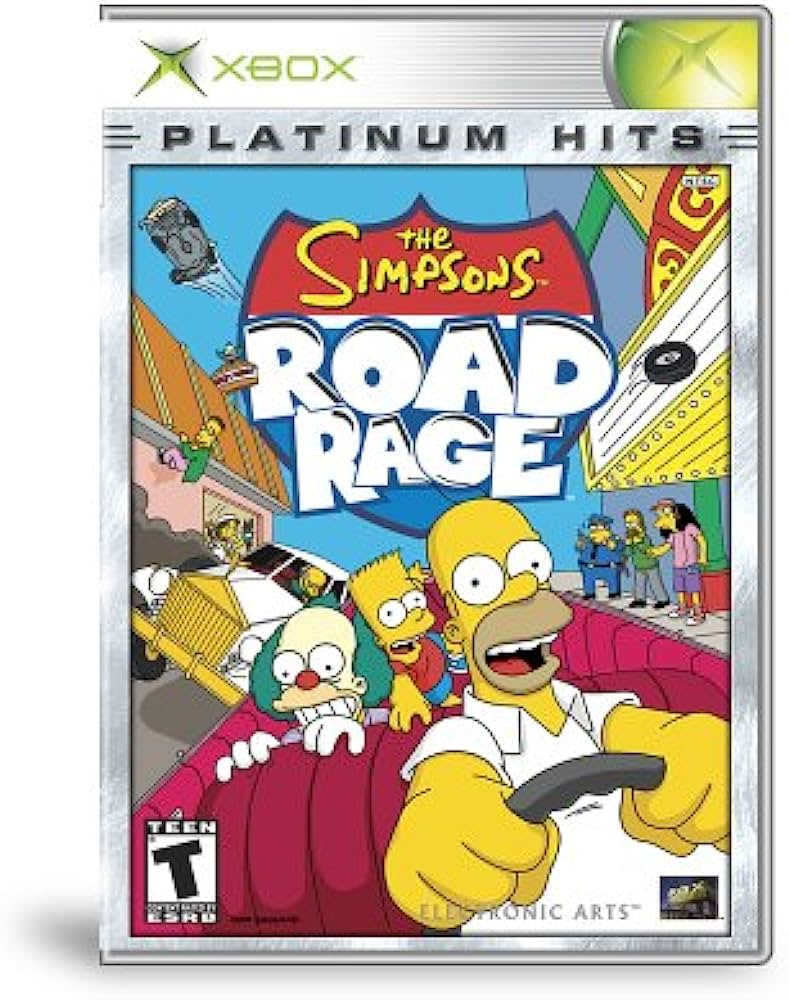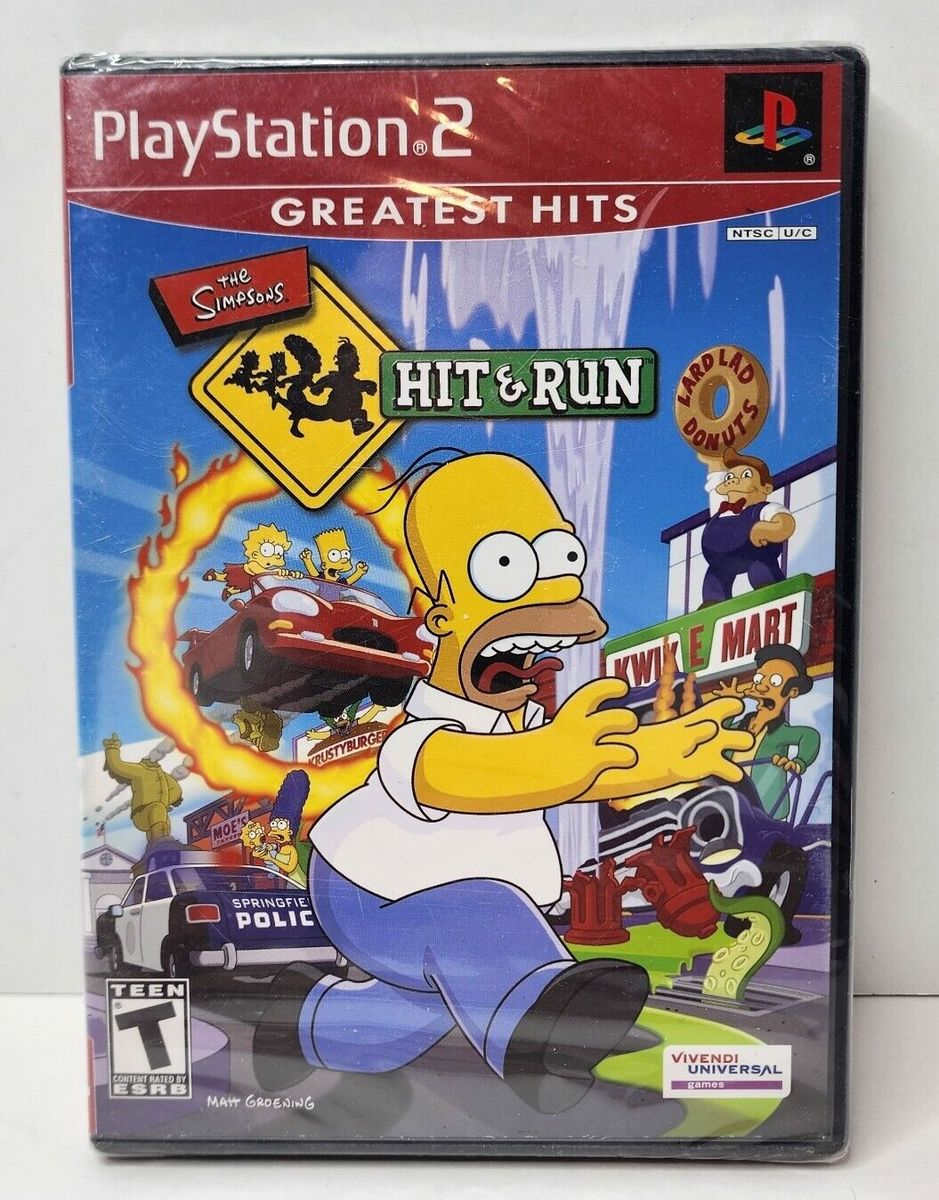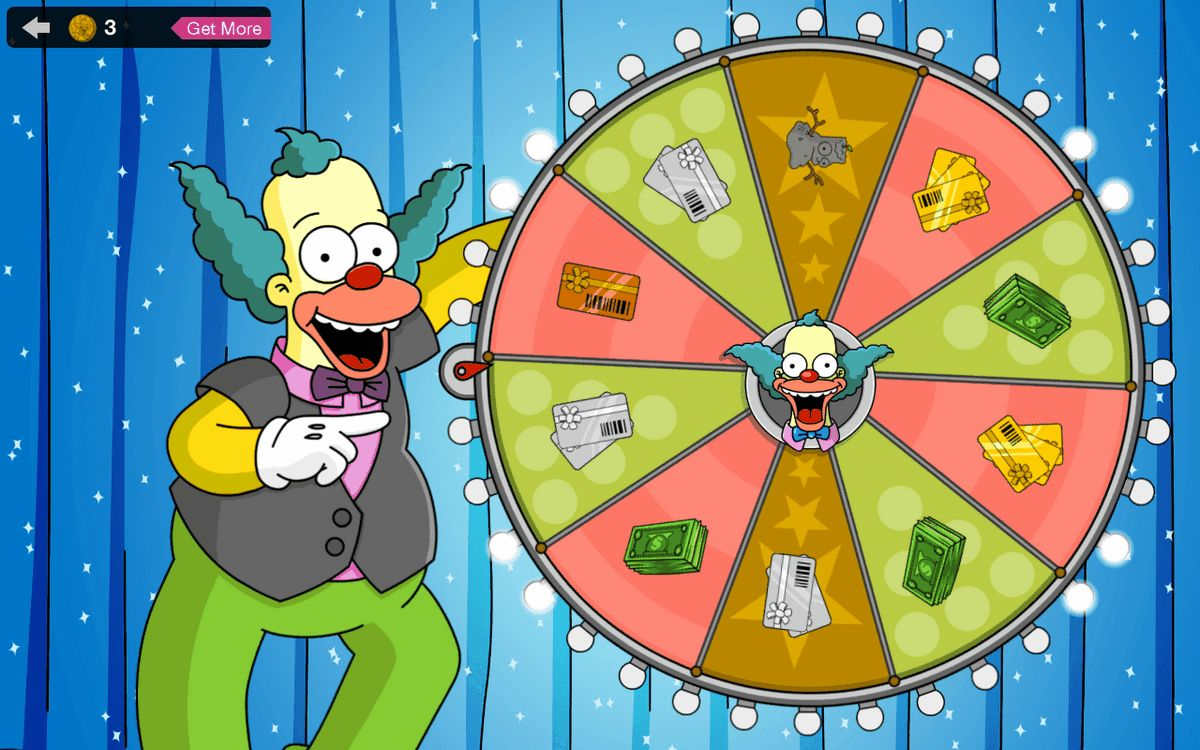
The Simpsons: Hit & Run is a classic action-adventure game that was released in 2003. Developed by Radical Entertainment and published by Vivendi Universal Games, this game quickly became popular among fans of the animated sitcom The Simpsons due to its immersive gameplay mechanics and engaging storyline.
Set in the fictional town of Springfield, players take on the role of various characters from the show as they explore different neighborhoods while completing tasks and missions. Alongside an overarching story arc involving mysterious alien activity in the town, players are required to navigate through driving levels using vehicles ranging from Homer’s iconic pink sedan to Mr. Plow’s snowplow.
As one of the earliest examples of an open-world game based on an existing IP (intellectual property), The Simpsons: Hit & Run provided fans with a unique opportunity to step into their favorite character’s shoes and interact with locations featured throughout the series such as Moe’s Tavern and Krusty Burger.
In this article, we will delve into what made The Simpsons: Hit & Run such a beloved title for gamers worldwide. From exploring its innovative use of humor to analyzing how it set itself apart from other games within its genre, we’ll provide readers with all they need to know about this celebrated entry in video game history.
- Overview of “The Simpsons: Hit & Run” and its impact on the gaming industry
- Analysis of game mechanics, including driving physics and mission structure
- Comparison to other open-world games of the time, such as “Grand Theft Auto”
- Examination of the game’s humor and how it captures the essence of The Simpsons TV show
- Exploration of Easter eggs and hidden content within the game world
- Discussion on the importance of licensed games in today’s market
- Personal retrospective from gamers who grew up playing “The Simpsons: Hit & Run”
- Critique on potential re-releases or remasters for modern consoles
Overview of “The Simpsons: Hit & Run” and its impact on the gaming industry
Developed by Radical Entertainment and published by Vivendi Universal Games, this game was released for GameCube, PlayStation 2, Xbox, and Microsoft Windows platforms. It follows the storyline of Homer Simpson as he discovers a sinister conspiracy that involves aliens taking over Springfield.
The impact of The Simpsons: Hit & Run on the gaming industry cannot be overstated. It marked the first time that players could explore an open-world version of Springfield in a video game. This concept has since become commonplace in modern gaming with titles such as Grand Theft Auto V being prime examples. Additionally, it featured many mini-games throughout the world which became a staple feature in later games like Assassin’s Creed or Watch Dogs.
Furthermore, The Simpsons: Hit & Run proved to be wildly successful commercially selling well over three million copies worldwide and setting records for its publisher at the time. Its success paved the way for future licensed games to take creative risks instead of just replicating existing formulas – something Spider-man PS4 took advantage of recently with similar success levels.
All said; The Simpsons:Hit&Run influenced much more than just those who played it directly but also impacted how developers approached licensed games moving forward – making them not only cash-grabs but fun-filled experiences worth one’s while!
Analysis of game mechanics, including driving physics and mission structure
One of the key aspects that make this game unique is its driving physics mechanics, which have been designed to provide a realistic experience during car chases and races. The gameplay includes various elements such as traffic lights, destructible objects, and obstacles on the road that require players to master their driving skills.
Furthermore, the mission structure in The Simpsons: Hit & Run also deserves attention. Each mission has a specific objective that must be accomplished within a given time limit. Players need to use their problem-solving skills along with quick reflexes to achieve success in these missions. Moreover, each level increases in difficulty as players progress through them making it more challenging for them.
Overall, The Simpsons: Hit & Run provides an engaging gaming experience due to its unique blend of entertaining missions and well-designed driving mechanics that allow for free-roaming exploration while progressing through levels filled with humor from classic characters from ‘The Simpson’s franchise’.
Comparison to other open-world games of the time, such as “Grand Theft Auto”
Grand Theft Auto III had popularized the genre two years prior, and its influence can be seen in many aspects of Hit & Run’s design. However, while both games share some similarities, they also differ significantly in terms of gameplay mechanics and overall tone.
One of the most notable differences between the two games is their thematic focus. While Grand Theft Auto III revels in violence and criminality, Hit & Run takes a more lighthearted approach by parodying various elements of American pop culture. This is reflected not only in the game’s dialogue and humor, but also in its mission structure; instead of engaging in brutal shootouts or heists like you would do in GTA III, players are tasked with completing objectives that involve gathering items for missions or driving around town to complete errands.
In terms of gameplay mechanics, Hit & Run also differs from GTA III on several fronts. For example, the game features fewer weapons than its predecessor – which means that combat encounters are less frequent – but it compensates for this by giving players access to a variety of vehicles that can be used to explore Springfield’s different neighborhoods at their leisure. Additionally, while both games allow players to hijack cars belonging to NPCs (non-player characters), Hit & Run adds an interesting twist by allowing them to play as Homer Simpson himself – who has his own unique set of animations and abilities that make him feel distinct from other playable characters.

Overall then, while there are certainly similarities between The Simpsons: Hit & Run and Grand Theft Auto III – such as their shared emphasis on non-linear exploration within large open-world environments – each game ultimately offers a unique experience that sets it apart from the other.
Examination of the game’s humor and how it captures the essence of The Simpsons TV show
One way in which it achieves this is through its satirical take on American pop culture, as seen through various characters and locations throughout Springfield. From Krusty Burger to the Kwik-E-Mart, players are immersed in a world that feels both familiar yet comically exaggerated.
The humor within the game also extends beyond its setting and into its dialogue and missions. Players will encounter classic Simpsons moments such as Homer getting stuck inside a vending machine or Marge being chased by police officers due to her dangerous driving. These moments not only provide laughs but also serve as nod to long-time fans of the franchise.
Moreover, The Simpsons: Hit & Run uses witty writing and clever references to further enhance its humor. For example, when visiting Professor Frink’s lab, players may hear him say “Good glayvin!” referencing his catchphrase from the TV show while examining futuristic technology. This level of attention to detail highlights how much care was taken during development towards capturing what makes The Simpsons so beloved by audiences worldwide.
Overall, The Simpsons: Hit & Run stands out for how well it captures the comedy stylings of Matt Groening’s creation while also delivering an engaging gameplay experience for all types of gamers.

Exploration of Easter eggs and hidden content within the game world
These hidden features are often included as a way to encourage players to explore the game’s world in greater detail, adding an additional layer of depth and complexity to the experience. One perfect example of this type of feature can be found in The Simpsons: Hit & Run.
Within Hit & Run’s open-world setting, players will find a wide range of Easter eggs and hidden content peppered throughout Springfield. Some examples include references to classic episodes from the TV series, such as Krusty Burger locations that pay homage to classic gags like “Krusty partially guarantees your satisfaction” or “We spit in every fiftieth burger”. Additionally, there are secret character skins that unlock after completing certain tasks or missions.
These types of Easter eggs not only reward dedicated fans who want to explore every nook and cranny within Springfield but also serve as an incentive for more casual gamers who may not have discovered these secrets otherwise. Moreover, they add lasting value by creating replayability through encouraging further exploration beyond just gameplay progression; something which keeps players coming back long after their initial playthroughs have been completed. In conclusion, the inclusion of well-crafted Easter eggs adds richness and diversity into gaming experiences – making them much more enjoyable!
Discussion on the importance of licensed games in today’s market
With the proliferation of multimedia platforms, consumers are inundated with content from a myriad of sources and finding ways to differentiate products is increasingly difficult. Licensed games provide a means for developers to stand out from the crowd by leveraging popular brands and intellectual properties that fans have an emotional attachment to.
Game The Simpsons: Hit & Run exemplifies this trend perfectly as it offers players an immersive experience in Springfield, the fictional hometown of America’s favorite animated family. By incorporating well-known characters such as Homer Simpson and his family into the game, developer Radical Entertainment was able to tap into a pre-existing fanbase which gave them a distinct advantage over other titles on the market.
Furthermore, licensed games offer unique marketing opportunities for both developers and license holders alike. For instance, Game The Simpsons: Hit & Run utilized promotional tie-ins with Burger King restaurants across North America to drive sales volume – further demonstrating how licensing agreements can create synergies between different industries.
In conclusion, licensed games play an important role in today’s crowded gaming marketplace by allowing developers to differentiate their products through high profile brand associations while providing marketing opportunities that may not exist otherwise. Game The Simpsons: Hit & Run serves as an example of how these partnerships can lead to successful titles enjoyed by millions around the world.
Personal retrospective from gamers who grew up playing “The Simpsons: Hit & Run”
As an expert in gaming, I can confidently say that this game was ahead of its time and still holds up to today’s standards. One of the main reasons why this game stands out from other titles is its incorporation of open-world gameplay mechanics into a licensed product. The ability to explore Springfield as your favorite characters from “The Simpsons” made the game feel like an extension of the show itself.
Gamers who played “The Simpsons: Hit & Run” as children have fond memories of completing missions, collecting coins, and unlocking new vehicles in-game. However, upon reflection, these same individuals now appreciate how much depth and detail went into creating such a massive world for players to explore freely. They also recognize the clever writing and humor that perfectly emulated what fans loved about “The Simpsons.”
In conclusion, gamers’ personal retrospectives on their experiences with “The Simpsons: Hit & Run” further cement its status as a classic video game title. Its innovative gameplay mechanics combined with faithful representation of beloved characters make it stand out even after all these years since its release. It remains one of those games where discussions about nostalgia are not complete without mention; truly timeless entertainment!
Critique on potential re-releases or remasters for modern consoles
While it is tempting to bring back classic titles such as The Simpsons: Hit & Run, it is important to consider whether the game would still hold up in today’s market and whether a remaster would truly add value.

One factor to consider is the technological advancements of modern consoles. The original version of The Simpsons: Hit & Run was released in 2003 on PlayStation 2, Xbox, and GameCube. The graphics and gameplay mechanics may not meet the standards that gamers have come to expect from current-generation platforms such as PlayStation 5 or Xbox Series X/S. Therefore, before investing in a remaster, developers need to overhaul these aspects of the game while keeping the essence of what made it famous intact.
Additionally, there are concerns about oversaturation within gaming markets. With so many new games being released each year across multiple genres and platforms, risking consumer fatigue by releasing too many re-releases could actually detract from sales rather than boosting them. As an alternative solution for classic games like The Simpsons: Hit & Run that are struggling with compatibility issues on newer hardware systems yet have huge fanbases who long for them– I believe cloud-based streaming could provide access without drastically altering anything about how they originally played.
In conclusion, while revisiting old favorites can generate hype among existing fans of franchises like The Simpson’s: Hit & Run; however modernizing their outdated design elements without losing its core essence needs time-consuming investment from developers which might not always prove profitable given risks involved . A better way forward may lie in exploring alternative solutions like cloud-based streaming that enable fans to experience these beloved classics again without negatively impacting contemporary gaming ecosystems through cluttered marketplaces over-saturation techniques instead offering universal accessibility through online services via internet connectivity regardless hardware limitations faced by players themselves resulting into wider audience reach.
To conclude, The Simpsons: Hit & Run is a game that has undoubtedly left a lasting impression on the video game industry. Its unique blend of open-world exploration, driving mechanics, and classic humor from one of the most beloved animated sitcoms in history has made it an instant classic.
From its vibrant and colorful setting to its well-crafted storyline and engaging missions, this game stands out as an excellent example of what can be achieved with careful planning and execution. It captures the essence of The Simpsons while also providing players with a fun-filled experience that keeps them wanting more.
Furthermore, The Simpsons: Hit & Run’s contribution to the emergence of open-world games cannot be overstated. It provided gamers with a glimpse into what could be possible in terms of creating vast virtual worlds filled with interesting characters, vehicles to control, missions to complete and secrets to uncover.
Overall it’s fair to say that The Simpsons: Hit & Run is not just another licensed tie-in; instead, it exemplifies how such partnerships between media industries can lead to successful products within their respective markets. Undoubtedly this game will continue being remembered by fans all over the world for many years if not decades to come.
Read More:- Unleash Chaos in Liberty City: Grand Theft Auto III Game Review.
- Explore the Wild World of Vice City with Grand Theft Auto: Vice City – Your Ultimate Gaming Experience!.
- Experience the Thrill of Crime with Grand Theft Auto V – The Ultimate Gaming Adventure!.
- Get ready for epic adventures with One Piece: Grand Adventure game – Join the Pirates now!.
- Unleash Chaos with Buffy the Vampire Slayer: Chaos Bleeds Game – A Spine-Tingling Adventure!.
- Experience the Thrill of Racing with Midtown Madness 2 – The Ultimate Game!.
- Experience the Thrill of Off-Roading with Test Drive Off-Road Wide Open Game.